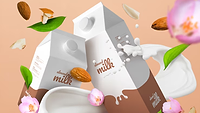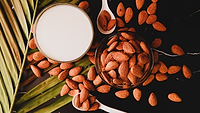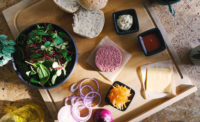Reducing Spoilage of Plant-Based Milk with Flash Freezing

Image credit: hello aesthe via Pexels
A simple definition of flash freezing is lowering the temperature of food ingredients to 32 °F (0 °C) while keeping the cells in the food item intact. This allows for a reduction in shipping costs and spoilage, since water is frozen in the food item. Another benefit of flash freezing is retention of nutrition content of the final product, such as vitamins and minerals. It is important to note that ice crystals affect cell integrity over a period of time, as the cellular structure exhibits significant differences before and after flash freezing. The cellular structure of a food is intact before freezing, while frozen food items have small ice crystals (Figure 1).
Figure 1. The Flash Freezing Process (Image Created with Canva by Muayyad Karadsheh)
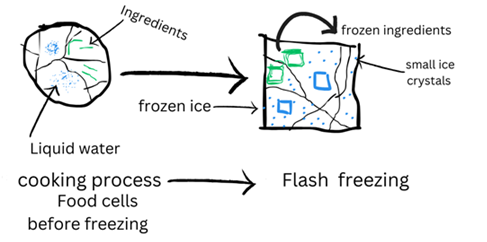
Does Flash Freezing Work for Plant-Based Milk?
Temperature control is a significant factor in extending the shelf life of plant-based milk. Textural attributes and temperature are directly related, and can lead to a different viscosity for the final product. Plant-based milk requires colder temperatures to remain shelf-stable, and flash freezing is an option for extending shelf life (Figure 2).
As shown in Figure 1, fewer ice crystals are formed in the final product. This change in cell structure improves product quality and results in less damage during defrosting, as the ice crystals are not large. Moreover, flash freezing equipment increases moisture retention in thawed and cooked products like baked goods and produce. A blast freezer can be used to improve shelf life for a variety of products. For example, the shelf life of date juice packed in low-density polyethylene bags can be extended to six months through flash freezing, according to one study.
Figure 2. Flash Freezing is an Option for Extending the Shelf Life of Plant-Based Milk (Image Credit: Unsplash by Maryam Sicard)
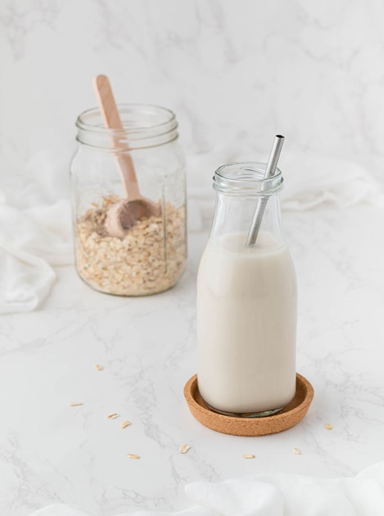
Options for Reducing Oxygen and Spoilage with Flash Freezing
Food spoilage is the result of several factors, one of which is the level of moisture in the food. Flash freezing can be used to reduce spoilage, and is a viable option for plant-based milk. Several interventions can be applied to improve the quality and safety of the product, especially with regard to packaging.
After flash freezing, the product should be stored in a dark container, and the container should be kept away from light to reduce oxidation. A stainless steel or tinted glass container can be used for plant-based milk. Nitrogen flushing can also be used to pump out oxygen, which protects the flavor and preserved the vitamin content of milk. Oxygen absorbers can also help increase the shelf life of plant-based milk. Airtight containers should be used to seal the bottle tight against oxygen. Possible options for airtight containers include polyethylene terephthalate or low-density polyethylene pouches.
Alteration in water content of a product changes microbiological activity. As flash freezing can help control the water content of a food product such as plant-based milk, it can also help improve the quality, safety, and shelf life of the final product. For more information and further reading on flash freezing for plant-based milks and other food products, please see the References Consulted section at the end of this article.References Consulted
- Bomgardner, M. "Extending Shelf Life With Natural Preservatives." Chemical & Engineering News 96, no. 6. February 10, 2014. https://cen.acs.org/articles/92/i6/Extending-Shelf-Life-Natural-Preservatives.html.
- Maghsoudlou, Y., M. Alami, M. Mashkour, M.H. Shahraki. "Optimization of Ultrasound-Assisted Stabilization and Formulation of Almond Milk." Journal of Food Processing and Preservation 40, no. 5. November 20, 2015. https://ifst.onlinelibrary.wiley.com/doi/pdf/10.1111/jfpp.12661.
- Rysstad, G. and J. Kolstad. "Extended Shelf Life Milk—Advances in Technology." International Journal of Dairy Technology 59, no. 2. April 21, 2006. https://onlinelibrary.wiley.com/doi/full/10.1111/j.1471-0307.2006.00247.x.
- Tazi, S., F. Plantevin, C. Di Falco, A. Puigserver, and E. .H.H. Ajandouz. "Effects of light, temperature and water activity on the kinetics of lipoxidation in almond-based products." Food Chemistry 115, no. 3. January 14, 2009. https://www.sciencedirect.com/science/article/pii/S0308814609000405.
- Simuang, J. "Effects of fat content and temperature on the apparent viscosity of coconut milk." Journal of Food Engineering 64, no. 2. November 7, 2003. https://www.sciencedirect.com/science/article/abs/pii/S0260877403003923.
- Kulkarni, S.G., P. Vijayanad, and L. Shubha. "Effect of processing of dates into date juice concentrate and appraisal of its quality characteristics." Journal of Food Science and Technology 47. April 10, 2010. https://link.springer.com/article/10.1007/s13197-010-0028-y.
- Cichello, S.A. "Oxygen absorbers in food preservation: a review." Journal of Food Science and Technology 52, no. 4. February 6, 2014. https://www.ncbi.nlm.nih.gov/pmc/articles/PMC4375217/#!po=20.5357.
- Johnson, D.S., S.E. Duncan, L.M. Bianchi, H.H. Chang, W.N. Eigel, and S.F. O'Keefe. "Packaging modifications for protecting flavor of extended-shelf-life milk from light." Journal of Dairy Science 98, no. 4. February 04, 2015. http://dx.doi.org/10.3168/jds.2014-8857.
Looking for a reprint of this article?
From high-res PDFs to custom plaques, order your copy today!



